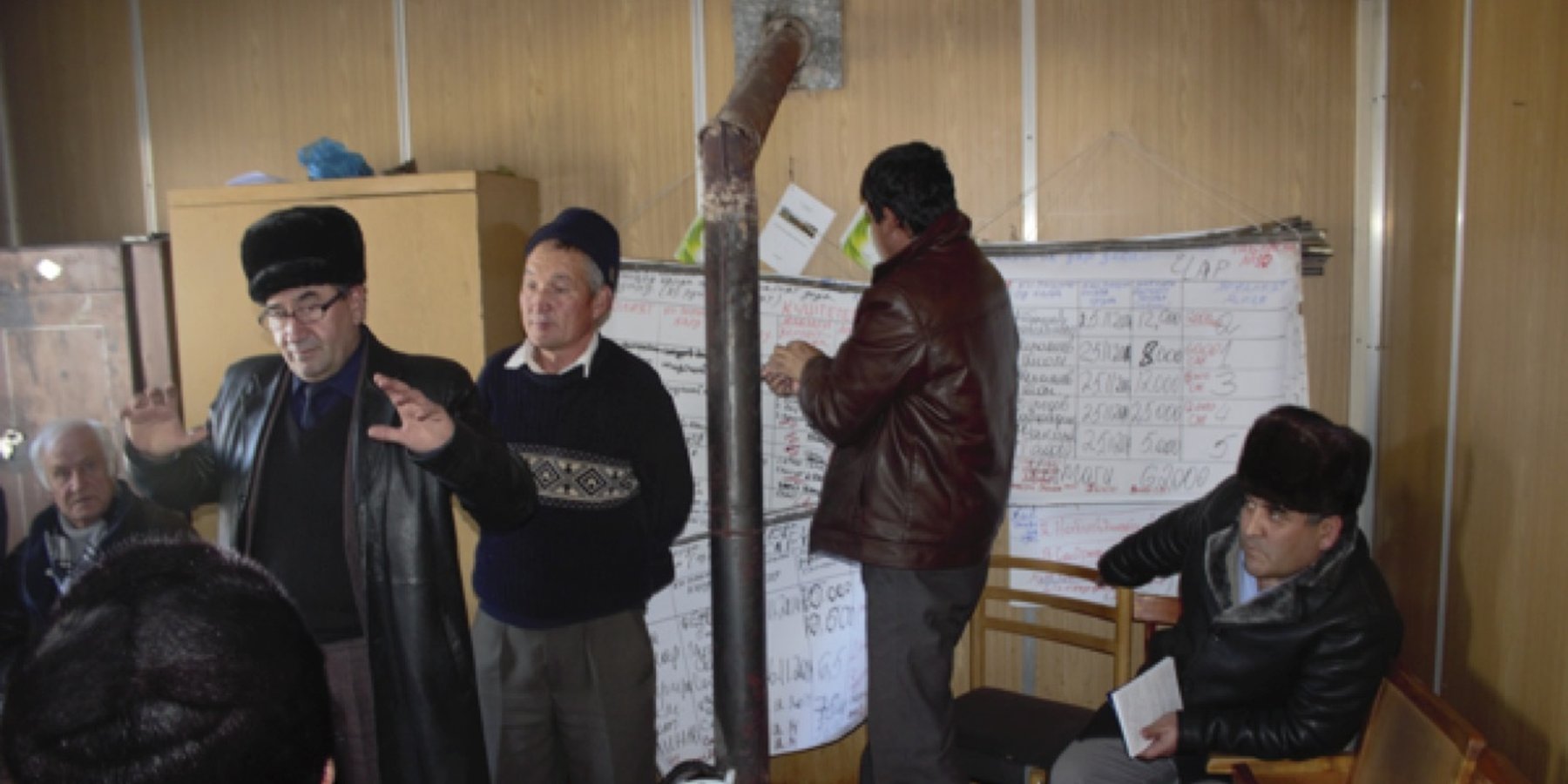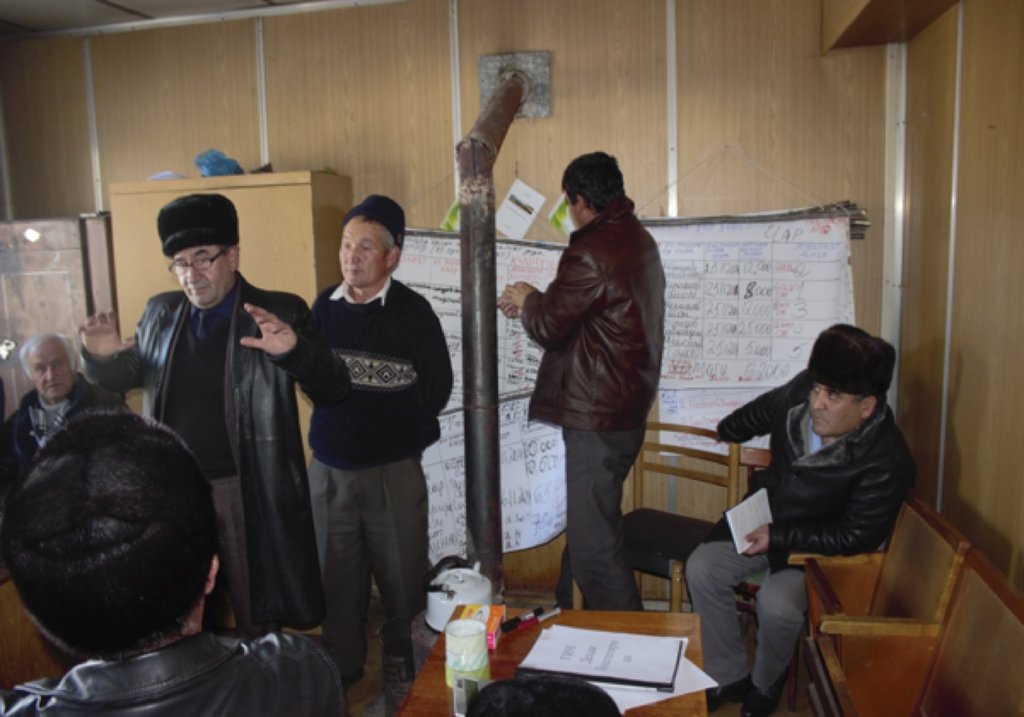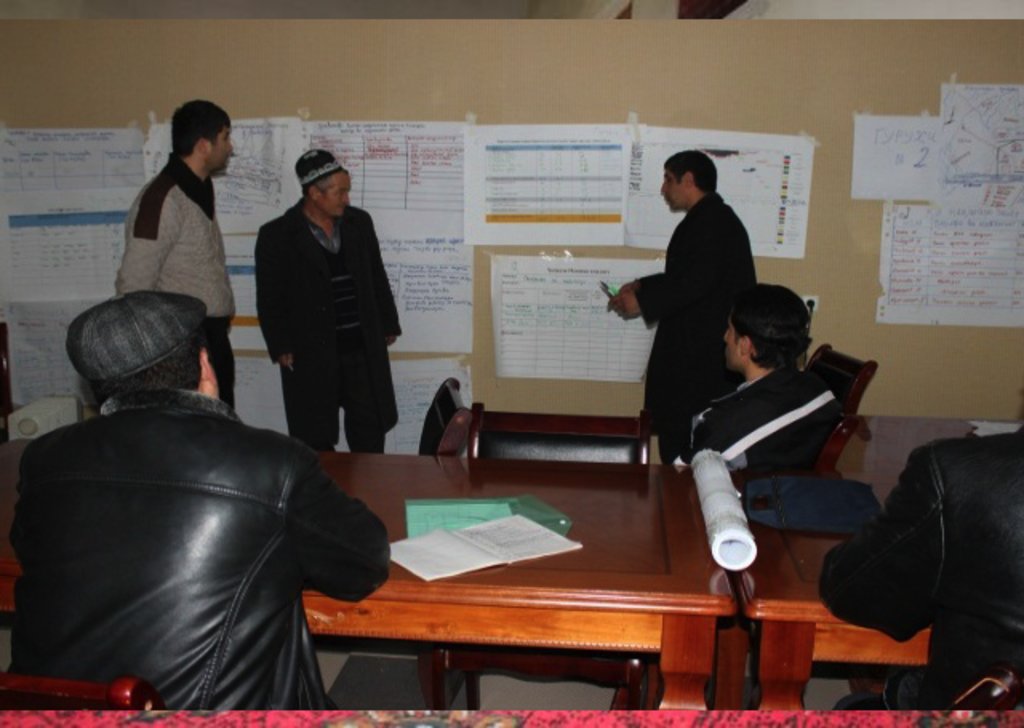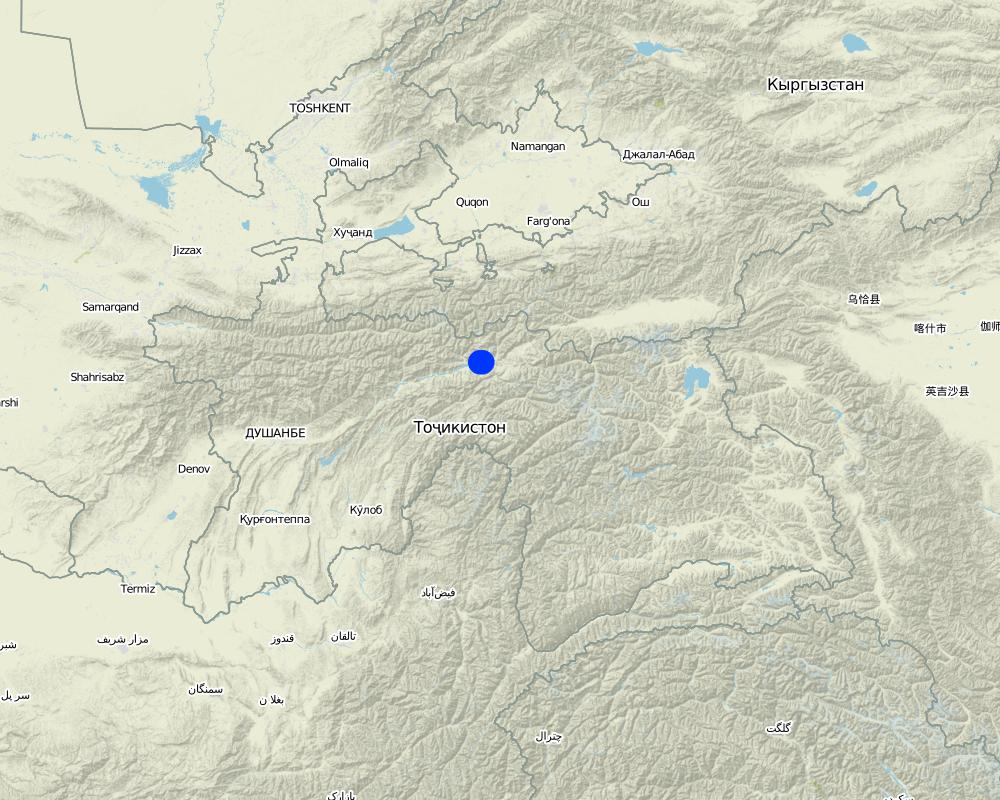Pasture and Livestock Management Plan [ทาจิกิสถาน]
- ผู้สร้างสรรค์:
- การอัพเดท:
- ผู้รวบรวม: Askarsho Zevarshoev
- ผู้เรียบเรียง: –
- ผู้ตรวจสอบ: Yacime Khadraoui, Maximilian Knoll
Накшаи Идоракунии Чорво ва Чарогох
approaches_3459 - ทาจิกิสถาน
ดูส่วนย่อย
ขยายทั้งหมด ย่อทั้งหมด1. ข้อมูลทั่วไป
1.2 รายละเอียดที่ติดต่อได้ของผู้รวบรวมและองค์กรที่เกี่ยวข้องในการประเมินและการจัดเตรียมทำเอกสารของแนวทาง
ชื่อของโครงการซึ่งอำนวยความสะดวกในการทำเอกสารหรือการประเมินแนวทาง (ถ้าเกี่ยวข้อง)
Environmental Land Management and Rural Livelihoods (ELMAR)ชื่อของโครงการซึ่งอำนวยความสะดวกในการทำเอกสารหรือการประเมินแนวทาง (ถ้าเกี่ยวข้อง)
Aga Khan Foundation (Aga Khan Foundation) - สวิตเซอร์แลนด์1.3 เงื่อนไขที่เกี่ยวข้องกับการใช้ข้อมูลที่ได้บันทึกไว้ผ่านทาง WOCAT
วันที่เก็บรวบรวมข้อมูล (ภาคสนาม):
15/07/2014
ผู้รวบรวมและวิทยากรหลักยอมรับเงื่อนไขเกี่ยวกับการใช้ข้อมูลที่ถูกบันทึกผ่านทาง WOCAT:
ใช่
1.4 การอ้างอิงถึงแบบสอบถามเรื่องเทคโนโลยี SLM
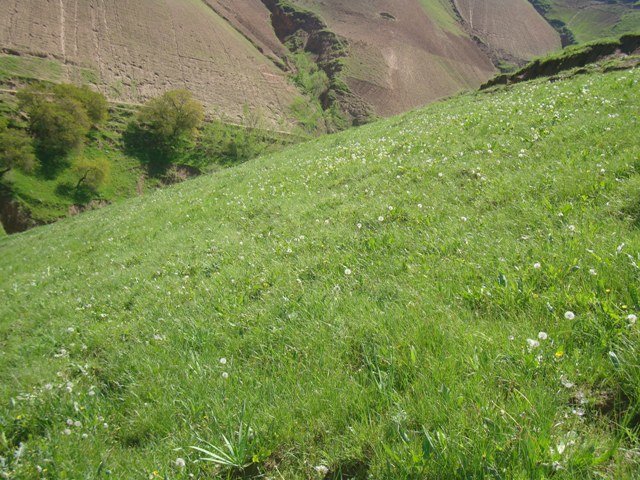
Rehabilitation of degraded pastures with alfalfa [อัฟกานิสถาน]
Degraded pastures are restored with alfalfa through broad seeding method. The area is put under quarantine for three years to allow for the pasture to restore sufficiently.
- ผู้รวบรวม: Bettina Wolfgramm
2. คำอธิบายของแนวทาง SLM
2.1 การอธิบายแบบสั้น ๆ ของแนวทาง
"Pasture and Livestock Management Plan" is a participatory approach which is guiding pasture users, members of Pasture User Unions and Pasture User Groups to develop their action plan on pasture and livestock management. The approach brings together stakeholders, who are involved at any stage in pasture management or can contribute to or impede the implementation of the pasture livestock management plan.
2.2 การอธิบายอย่างละเอียดของแนวทาง
การอธิบายอย่างละเอียดของแนวทาง:
Pasture and Livestock Management Plan (PLMP) Approach is a participatory approach towards the development of a pasture plan with communities to ensure a sustainable use of pasture resources. It was especially designed for the needs of the Pasture User Union, a new structure allowed to establish at community level to implement better management of their pasture resources. Though a step-by-step analysis of the current situation a community will come up with detailed action plan for the following three years. The PLMP involves, but is not limited to, the establishment of a committee involved in preparation of the PLMP, as well as a stakeholder analysis and the determination of the carrying capacity of pasture resources by comparing the existing fodder resources and requirements for the fodder. Based on that analysis, an action plan will be developed with involvement of all stakeholders to reach an agreement on approaches and technologies to implement the interventions. The PLMP will lead to the development of the Action Plan based on the discussion between different stakeholders. In the process of the plan development with consideration of an expert a clear roles and responsibilities of all involved actors/stakeholder in a defined timeframe will be identified.
The main objectives is to support land users with development of actions, which contribute to the sustainable development of pasture resource and livestock development. The central focus is given to balance the need of the livestock owners to improve livestock productivity with compromising the environmental conditions for the next generations and ecosystem services. The planning process should contribute to better management of pasture lands, rehabilitation of degraded pastures, resolving any existing conflict over pasture use, awareness raising on the role of pasture land for ecosystem services and overall trends in development with regards to use and management of pasture resources.
The process is based on participatory methods with involvement of different stakeholders capturing main principles for land use planning. The process includes pasture users/livestock owners who are involved in day to day management of pasture lands, local government with related department to pasture use, land owners, different departments of local government such as forestry, land use committee, environmental protection etc.
The approach is conducted in three main stages: In the firs stage consultation with pasture users will be held to identify the need for development of a pasture plan. Then an inventory of all land resources, including pasture land and livestock numbers will be conducted. In the third stage a workshop will be conducted with involvement of all stakeholders, where the pasture plan will be developed. In the final stage of the pasture plan development an action plan with defined clear activities in a given frame and assigned responsible persons will be developed.
Land users, who also own livestock appreciate their involvement in the pasture development planning. They also like when their voice is taken into consideration in making any decision with regards to the pasture use.
2.3 รูปภาพของแนวทาง
ข้อสังเกตทั่วไปเกี่ยวกับรูปภาพ:
Participants reflecting on the overall process of the PLMP approach with all steps involved starting with setting up objectives and principles, analysis of stakeholders up to development of action plan.
2.5 ประเทศ ภูมิภาค หรือสถานที่ตั้งที่ได้นำแนวทางไปใช้
ประเทศ:
ทาจิกิสถาน
ภูมิภาค/รัฐ/จังหวัด: :
Rasht Valley/Lakhsh District
ข้อมูลเฉพาะเพิ่มเติมของสถานที่ตั้ง:
PUUs established in Rasht Valley under ELMARLP
Map
×2.6 วันที่เริ่มต้นและสิ้นสุดของแนวทาง
ถ้าไม่รู้ปีที่แน่นอนให้ประมาณวันที่ที่ริเริ่มใช้แนวทางนี้ :
น้อยกว่า 10 ปี (เร็วๆนี้)
2.7 ประเภทของแนวทาง
- ใช้โครงงานหรือแผนงานเป็นฐาน
2.8 เป้าหมายหรือวัตถุประสงค์หลักของแนวทาง
The main objective is to support land users with the development of actions, that contribute to the sustainable development of pasture resource and livestock development. The central focus is to balance the need of the livestock owners to improve livestock productivity without compromising the environmental conditions for next generations and ecosystem services. The planning process should contribute to better management of pasture lands, rehabilitation of degraded pastures, resolving any existing conflicts over pasture use, raise awareness on the role of pasture land for ecosystem services and overall trends in development with regards to use and management of pasture resources.
2.9 เงื่อนไขที่เอื้ออำนวยหรือเป็นอุปสรรคต่อการนำเทคโนโลยีภายใต้แนวทางนี้ไปปฏิบัติใช้
บรรทัดฐานและค่านิยมทางสังคม วัฒนธรรม ศาสนา
- เป็นอุปสรรค
Communities are used to an ad hoc use of natural resources and therefore sometime not willing to structured planning processes in terms of use of pasture resources.
การมีไว้ให้หรือการเข้าถึงแหล่งการเงินและบริการ
- เป็นอุปสรรค
In the case that funding is not available from project side, it may hinder further implementation of the actions planned under the PLMP approach.
การจัดตั้งระดับองค์กร
- เอื้ออำนวย
The PLMP approach is specifically designed for the PUU, which are legally registered institutes under the governmental law. This enables the process to run continously.
การร่วมมือหรือการทำงานประสานกันของผู้ลงมือปฏิบัติ
- เอื้ออำนวย
Depending on the leadership of the institutional structure, if well managed, it can enable collaboration among different stakeholders
- เป็นอุปสรรค
The newly established PUUs do not have enough power to influence the institutes in which stakeholders who are not interested in the sustainable use of pasture resources work hinder the planning process.
กรอบแนวทางในการดำเนินการด้านกฎหมาย (การถือครองที่ดิน สิทธิในการใช้ที่ดินและน้ำ)
- เอื้ออำนวย
mainly used by the PUUs, which are are functioning in the framework of state law
นโยบาย
- เอื้ออำนวย
The plan is developed for the Pasture User Unions, which are legal structure responsible for pasture management at community level.
การกำกับดูแลที่ดิน (การตัดสินใจ การนำเอาไปปฏิบัติใช้ และการบังคับใช้)
- เอื้ออำนวย
The approach will enable community members (PUUs) to become legal owners of the pasture resources according to the Pasture Law of the Republic of Tajikistan.
ความรู้เกี่ยวกับ SLM การเข้าถึงการสนับสนุนด้านเทคนิค
- เอื้ออำนวย
Experts in the field are supported technically by project consultants, several trainings on the process and approach are conducted for them.
3. การมีส่วนร่วมและบทบาทของผู้มีส่วนได้ส่วนเสียที่เกี่ยวข้อง
3.1 ผู้มีส่วนได้ส่วนเสียที่เกี่ยวข้องในแนวทางนี้และบทบาท
- ผู้ใช้ที่ดินระดับท้องถิ่นหรือชุมชนระดับท้องถิ่น
livestock owners and PUU members
involved in direct process development and implementation of the approach
- องค์กรที่ขึ้นอยู่กับชุมชน
village organizations, pasture user unions
also registered in the framework of the state law and are represented in the PUU. mainly involved in mobilization of the community to participate in the development and implementation of the plan
- ผู้เชี่ยวชาญ SLM หรือที่ปรึกษาการเกษตร
project consultants and technical staff
facilitate the process of developing the PLMP approach, capacity building on the approach for the members of PUU
- องค์กรพัฒนาเอกชน
locally registered public organizations which are directly involved in the natural resource and environmental management
provide technical support to the community and land users; can also support with fundraising
- ภาคเอกชน
entrepreneurs at local level
co-funding of the implementation of some of the practices from the PLMP
- รัฐบาลระดับท้องถิ่น
local level government (sub-district authority), land use committee, committee of environmental protection, agriculture department etc.,
as one of the main stakeholders responsible for management of natural resource; can also provide overall supervision of the approach development; PUUs for which the PLMP is developed: legal structure under the Pasture Law of the Republic of Tajikistan.
ถ้ามีผู้มีส่วนได้ส่วนเสียหลายคนที่เกี่ยวข้องให้ระบุหน่วยงานตัวแทน:
Land Commttee
3.2 การเกี่ยวข้องของผู้ใช้ที่ดินระดับท้องถิ่นหรือชุมชนระดับท้องถิ่นในช่วงต่างๆของแนวทาง
| ความเกี่ยวข้องของผู้ใช้ที่ดินระดับท้องถิ่นหรือชุมชนระดับท้องถิ่น | ระบุผู้ที่มีส่วนเกี่ยวข้องและอธิบายกิจกรรม | |
|---|---|---|
| การริเริ่มหรือการจูงใจ | จ่ายเงินหรือสนับสนุนจากภายนอก | livestock owners, PUU members; consultation with livestock owners, facilitation the process of establishment of PUUs |
| การวางแผน | ปฏิสัมพันธ์ | land users, PUU members, pasture experts |
| การดำเนินการ | ปฏิสัมพันธ์ | PUU members and expert from project; consultation with stakeholders, conduct workshop and development of the plan |
| การติดตามตรวจสอบหรือการประเมินผล | จ่ายเงินหรือสนับสนุนจากภายนอก | from project team and management of PUU |
3.4 การตัดสินใจเลือกใช้เทคโนโลยี SLM
ระบุผู้ที่ทำการตัดสินใจเลือกเทคโนโลยีมากกว่าหนึ่งวิธีไปปฏิบัติใช้:
- ผู้เชี่ยวชาญ SLM เป็นผู้ตัดสินใจหลัก ที่ติดตามให้คำปรึกษากับผู้ใช้ที่ดิน
การอธิบาย:
Mainly as a new approach, best practices from the WOCAT database were used by the SLM specialists to introduce to land users and traditional practices were also applied based on the knowledge of land users.
ระบุว่าการตัดสินใจตั้งอยู่บนพื้นฐานของ:
- การประเมินความรู้ SLM ที่ได้ทำการบันทึกไว้เป็นอย่างดี (การใช้ข้อมูลในการตัดสินใจ)
- ประสบการณ์และความคิดเห็นส่วนตัว (ไม่ได้ลงบันทึกไว้)
4. การสนับสนุนด้านเทคนิค การสร้างขีดความสามารถ และการจัดการด้านความรู้
4.1 การสร้างขีดความสามารถ / การอบรม
ได้มีการจัดอบรมให้แก่ผู้ใช้ที่ดินหรือผู้มีส่วนได้ส่วนเสียคนอื่น ๆ หรือไม่:
ใช่
ให้ระบุว่าใครเป็นผู้ได้รับการอบรม:
- ผู้ใช้ที่ดิน
- เจ้าหน้าที่ภาคสนาม / ที่ปรึกษา
รูปแบบการอบรม:
- กำลังดำเนินการ
- จัดการประชุมสู่สาธารณชน
หัวข้อที่พูด:
"Pasture and Livestock Management Plan" methodology, proposal development for fund raising, Environmental Land Management
4.2 การบริการให้คำแนะนำ
ผู้ใช้ที่ดินมีการเข้าถึงการรับบริการให้คำปรึกษาหรือไม่:
ใช่
ระบุว่ามีบริการให้คำปรึกษาหรือไม่:
- ไปเยี่ยมชมสถานที่
การอธิบาย/แสดงความคิดเห็น:
During the project period continuos visits were organized to the project site to review the progress and provide advisory service. The project implmentation team consisting of different experts, including pasture, environmental specialists and monitoring and evaluation experts.
4.3 การเสริมความแข็งแกร่งให้กับสถาบัน (การพัฒนาองค์กร)
สถาบันได้รับการจัดตั้งขึ้นมาหรือเสริมความแข็งแกร่งโดยแนวทางนี้หรือไม่:
- ใช่ อย่างมาก
ระบุระดับของสถาบันที่ได้รับการเสริมความแข็งแกร่งหรือจัดตั้งขึ้นมา:
- ท้องถิ่น
อธิบายถึงสถาบัน บทบาทและความรับผิดชอบ สมาชิก เป็นต้น:
Pasture User Union was established at sub-district level.
ระบุประเภทของการให้ความช่วยเหลือสนับสนุน:
- ด้านการเงิน
- การสร้างขีดความสามารถ / การอบรม
ให้รายละเอียดเพิ่มเติม :
Different technical and administrative trainings were provided and the PUU was funded with certain amount for implementation of the PLMP approach.
4.4 การติดตามตรวจสอบและประเมินผล
การติดตามตรวจสอบและประเมินผลเป็นส่วนหนึ่งของแนวทางหรือไม่:
ใช่
ความคิดเห็น:
The final section of the PLMP is monitoring and evaluation. At each stage a responsible person among the stakeholders is assigned to conduct the plan implementation. In addition, the project team also conducts monitoring of the approach.
ถ้าตอบว่าใช่ แสดงว่าการจัดเตรียมเอกสารนี้มุ่งหวังที่จะเอาไปใช้สำหรับการติดตามตรวจสอบและประเมินผลใช่หรือไม่:
ใช่
ความคิดเห็น:
The implementing agency has a monitoring methodology, which will be used by the project team to conduct monitoring.
4.5 การวิจัย
การวิจัยเป็นส่วนหนึ่งของแนวทางหรือไม่:
ไม่ใช่
5. การสนับสนุนด้านการเงินและวัสดุอุปกรณ์
5.1 ระบุงบประมาณประจำปีสำหรับแนวทาง SLM นี้
ถ้าหากว่างบประมาณประจำปีไม่เป็นที่ทราบแน่นอน ให้ระบุช่วงลงไป:
- 2,000-10,000
แสดงความคิดเห็น (แหล่งของการระดมทุน ผู้บริจาคคนสำคัญ):
World Bank in the framework of ELMARL - Environmental Land Management and Rural Livelihood project
5.2 การสนับสนุนด้านการเงิน / วัสดุอุปกรณ์ให้แก่ผู้ใช้ที่ดิน
ผู้ใช้ที่ดินได้รับการสนับสนุนด้านการเงิน / วัสดุอุปกรณ์ไปปฏิบัติใช้เทคโนโลยีหรือไม่:
ไม่ใช่
5.3 เงินสนับสนุนสำหรับปัจจัยนำเข้า (รวมถึงแรงงาน)
- ไม่มี
ถ้าแรงงานโดยผู้ใช้ที่ดินเป็นปัจจัยนำเข้าที่มีอยู่มากมาย ระบุด้วยว่าเนื่องจาก:
- สมัครใจ
ความคิดเห็น:
This is traditional now and any project fund should be accompanied by contributions from communities, which is mainly labour on a voluntary basis
5.4 เครดิต
มีการจัดหาเครดิตมาให้ภายใต้แนวทาง SLM หรือไม่:
ไม่ใช่
5.5 แรงจูงใจหรือเครื่องมืออื่น ๆ
แรงจูงใจหรือเครื่องมืออื่น ๆ ได้ถูกนำไปใช้ส่งเสริมการใช้เทคโนโลยี SLM หรือไม่:
ไม่ใช่
6. การวิเคราะห์ผลกระทบและการสรุป
6.1 ผลกระทบของแนวทาง
ทำให้ผู้ใช้ที่ดินระดับท้องถิ่นมีอำนาจขึ้น ปรับปรุงการเข้าร่วมของผู้มีส่วนได้ส่วนเสียให้ดีขึ้นหรือไม่:
- ไม่ใช่
- ใช่ เล็กน้อย
- ใช่ ปานกลาง
- ใช่ อย่างมาก
It directly helped them to identify their status and understand their right to land use.
ช่วยให้ผู้ใช้ที่ดินนำเอาเทคโนโลยี SLMไปใช้และบำรุงรักษาสภาพไว้ได้หรือไม่:
- ไม่ใช่
- ใช่ เล็กน้อย
- ใช่ ปานกลาง
- ใช่ อย่างมาก
All technologies planned under the approach as part of their action plan were later financed by projects to implement.
after development of the pasture and livestock management plan the PUUs were supported financial from the ELMARL project to implement the plan
the plan is developed through conducted workshop with participation of all stakeholders, including land users, where they get opportunity to learn experiences of other stakeholders.
All stakeholders involved in the process including women and youth had an opportunity to make decisions in line with other stakeholders.
ช่วยบรรเทาความขัดแย้งหรือไม่:
- ไม่ใช่
- ใช่ เล็กน้อย
- ใช่ ปานกลาง
- ใช่ อย่างมาก
Roles and responsibilities identified all stakeholder and one of the objective to mitigate conflict brought under discussion conflict over pasture use and tried to solve it to some extent.
ทำให้กลุ่มด้อยโอกาสมีอำนาจทางสังคมและเศรษฐกิจหรือไม่:
- ไม่ใช่
- ใช่ เล็กน้อย
- ใช่ ปานกลาง
- ใช่ อย่างมาก
Women's role in livestock management was identified and empowered.
All stakeholders involved in the process including women and youth had an opportunity to make decisions in line with other stakeholders.
the approach give the land users/PUU members rights to become owner of the pasture under the Pasture Law of the Republic of Tajikistan
6.2 แรงจูงใจหลักของผู้ใช้ที่ดินเพื่อที่จะนำ SLM ไปปฏิบัติใช้
- การผลิตที่เพิ่มขึ้น
- การเสื่อมของที่ดินลดลง
The rotation plan for rehabilitation of degraded pasture is applied.
- ความเสี่ยงของภัยพิบัติลดลง
Watershed approach was applied to ban grazing in some areas to prevent land slide and mudflow as a result of degradation.
- กฎและระเบียบ (ค่าปรับ) หรือการบังคับใช้
The plan does not set certain rules at this stage to enforce the regulation, but the community is planning to negotiate and set certain rules in case of not following the regulations to implement the plan.
6.3 ความยั่งยืนของกิจกรรมของแนวทาง
ผู้ใช้ที่ดินสามารถทำให้สิ่งต่างๆ ที่ได้ปฏิบัติใช้โดยแนวทางนี้ยั่งยืนได้หรือไม่ (โดยไม่มีการสนับสนุนจากภายนอก):
- ไม่แน่ใจ
ถ้าตอบว่าไม่หรือไม่แน่ใจ ให้ระบุและแสดงความคิดเห็น :
depends on the availability of funding, leadership and support from other stakeholders, especially local government
6.4 จุดแข็งและข้อได้เปรียบของแนวทาง
| จุดแข็ง / ข้อได้เปรียบของแนวทางในทัศนคติของผู้ใช้ที่ดิน |
|---|
| active participation in the development of the plan |
| better understanding of the current situation with regards to pasture use and importance of pasture plan development |
| จุดแข็ง / ข้อได้เปรียบของแนวทางในทัศนคติของผู้รวบรวมหรือวิทยากรหลัก |
|---|
| involvement of all stakeholders, especially land users and taking their knowledge and voice into consideration in decision making |
| building of the knowledge and opening a platform for collaboration between different stakeholders interested in sustainable management of pasture resources |
6.5 จุดอ่อน / ข้อเสียเปรียบของแนวทางและวิธีในการแก้ไข
| จุดอ่อน / ข้อเสียเปรียบในทัศนคติของผู้ใช้ที่ดิน | สามารถแก้ไขปัญหาได้อย่างไร |
|---|---|
| time consuming, requires resource in the short term | should be understand as a means of livelihoods and spend more time, improve understanding of better gain in a long term |
| จุดอ่อน / ข้อเสียเปรียบในทัศนคติของผู้รวบรวมหรือวิทยากรหลัก | สามารถแก้ไขปัญหาได้อย่างไร |
|---|---|
| financial resources | should design longer term project to attract funding before the approach becomes self sustained |
| low capacity of the stakeholders, | more trainings, sharing of experiences |
| human resources | More focus should be given to younger generation to build their capacity and involve them in the approach development |
7. การอ้างอิงและการเชื่อมต่อ
7.1 วิธีการหรือแหล่งข้อมูล
- ไปเยี่ยมชมภาคสนาม การสำรวจพื้นที่ภาคสนาม
6
- การสัมภาษณ์กับผู้ใช้ที่ดิน
more than 50
- การสัมภาษณ์ผู้เชี่ยวชาญด้าน SLM หรือผู้ชำนาญ
5
- การเก็บรวบรวมมาจากรายงานและเอกสารที่มีอยู่
3
7.2 การอ้างอิงถึงสิ่งตีพิมพ์
ชื่อเรื่อง ผู้เขียน ปี ISBN:
Pasture and Livestock Management Plan Manual
ช่องทางในการสืบค้น และราคา:
Available upon request
7.3 เชื่อมโยงกับข้อมูลที่มีอยู่บนออนไลน์
ชื่อเรื่องหรือคำอธิบาย:
Pasture Management Networking Platform (PMNP)
URL:
https://pasture.klink.asia/dms/documents/groups/796?page=2
ลิงก์และโมดูล
ขยายทั้งหมด ย่อทั้งหมดลิงก์

Rehabilitation of degraded pastures with alfalfa [อัฟกานิสถาน]
Degraded pastures are restored with alfalfa through broad seeding method. The area is put under quarantine for three years to allow for the pasture to restore sufficiently.
- ผู้รวบรวม: Bettina Wolfgramm
โมดูล
ไม่มีโมดูล


